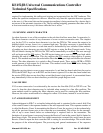
KS152JB Universal Communications Controller
Technical Specifications
Kawasaki LSI USA, Inc. Page 55 of 120 Ver. 0.9 KS152JB2
3.5 USING THE GSC
3.5.1 LINE DISCIPLINE
Line discipline is how the management of the transfer of data over the physical medium is con-
trolled. Two types of line discipline will be discussed in this section: full duplex and half duplex.
Full duplex is the simultaneous transmission and reception of data.Full duplex uses anywhere
from two to four wires. At least one wire is needed for transmission and one write for reception.
Usually there will also be a ground reference on each signal if the distance from station to station
is relatively long. Full-duplex operation in the dC152 requires that both the receive and the trans-
mit portion of the GSC are functioning at the same time. Since both the transmitter and receiver
are operating, two CRC generators are also needed. The C152 handles this problem by having one
32-bit CRC generator and one 16-bit CRC generator. When supporting full-duplex operation, the
32-bit CRC generator is modified to work as a 16-bit CRC generator. When ever the 16-bit CRC
is selected, the GSC automatically enters the full duplex mode. Half duplex with a 16-bit CRC is
discussed in the following paragraph.
Half duplex is the alternate transmission and reception of data over a single common wire. Only
one or two wires are needed in half-duplex systems. One wire is needed for the signal and if the
distance to be covered is long there will also be a wire for the found reference. In half-duplex
mode, only the receiver or transmitter can operate at one time. When the receiver or transmitter
operates is determined by user software, but typically the receiver will always be enabled unless
the GSC is transmitting. When using the C152 in half-duplex and the receiver is connected to the
transmitter it is possible that a station will receive its’ own transmission. This can occur if a
broadcast address is sent, the address mask register(s) are filled with all 1s, or the address being
sent matches the sending stations address through the use of the address masking registers. the
receiver must be disabled by the user while transmitting if any of these conditions will occur,
unless the user wants a station to receive its own transmission. The receiver is disabled by clearing
GREN (and GAREN if used). Half-duplex operation in the C152 is supported with either 16-bit or
32-bit CRCs. Whenever a 32-bit CRC is selected, only half-duplex operation can be supported by
the GSC. It is possible to simulate full-duplex operation with a 32-bit CRC, but this would require
that the CRC be performed with software. Calculating the CRC with the CPU would greatly
reduce the data rates that could be used with the GSC. Whenever a 16-bit CRC is selected, full-
duplex operation is automatically chosen and the GSC must be reconfigured if half duplex opera-
tion is preferred.
3.5.2 PLANNING FOR NETWORK CHANGES AND EXPANSIONS
A complete explanation on ho to plan for network expansion will not be covered in this manual as
there are far too many possibilities that would need to be discussed. But there are several areas
that will have major impact when allowing for changes in the system. In cases where there will
never be any changes allowed, expansion plans become a mute issue. However, it is strongly sug-
gested that there always be some allowance for future modifications.


















